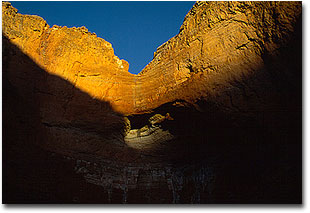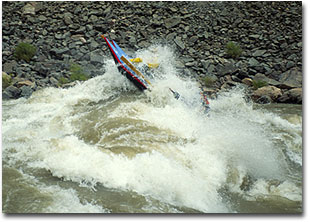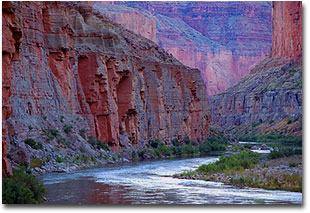|
|

All rights reserved.
We had never been on a whitewater river trip, and the Grand Canyon seemed to be the logical place to start. We got our name on a long list, and then waited with anticipation as our position on the list moved up annually. Finally, after seven years of waiting, we had to put our trip together in less than a year. We recruited friends (not difficult). We advertised for boatmen (somewhat difficult). We planned menus, prepared meals, lined up boats, researched and ordered gear, and coordinated travel (not easy). But when we eventually pushed off at Lee's Ferry, the tensions and anxieties of planning and organizing evaporated like virga beneath afternoon thunderheads. For the most part, the trip ranged from sensational to magnificent, although some days dropped to merely spectacular. A few basic numbers provide a hint of the experience: eighteen days, two hundred and thirty miles, one hundred and sixty rapids. But no numbers, words, or pictures can convey the sunrise light creeping down the Redwall limestone; the weeping wall at the head of Elves Chasm; the fluted, sculpted ebony of the Vishnu schist; or the difference between looking downstream at Crystal rapid and looking back upstream at it…you pretty much have to be there. Photographically, the trip was both frustrating and challenging. Riding in an oar-powered raft is not like hiking. You can't always get in the right positions for angles and lighting, and once you pass the shot, you definitely don't go back. There is a rough schedule to maintain, and with many unknowns on the trip, it is best to keep moving. Once I began to concentrate on the shots I could get instead of worrying about the ones I missed, the trip became a lot more relaxing. In reality, the opportunities are endless, and a variety of photographic themes can be carried downstream: geology, vegetation, water, camp life, floating, running the rapids. All can be handled with a mix of lenses and perspectives to portray the entire experience. The classic Grand Canyon shots materialize quickly on the water. It is best to float a little later into the evening to get the best reflections off the river. The best lens for raft work is a 28-85mm, which allows some moderate telephoto shots of scenery, plus a wide enough angle to photograph your companions in the same boat. On the small and medium size rapids, sitting behind and above the boatman with a 20mm lens provides an interesting composition. An 80-200mm is handy for the longer shots. 
High-contrast exposures are the order of the day, and you're constantly balancing highlights and shadow detail. Brightly lit walls over darker shadows produce many of the most spectacular images, and a spotmeter is indispensable. Don't be afraid to bracket, as film is relatively cheap considering the long wait to experience the adventure and the effort necessary to take the shots. I was surprised at the number and variety of hikes along the river. The Thunder River hike is one of the most spectacular I have been on anywhere. It's about ten miles roundtrip, and is worth a layover day at Tapeats to make. Most hikes, however, are not as long. But what they may lack in vistas, they make up for in intimacy. Water from springs has, over the centuries, carved narrow canyons on its way to the river. Each has its own personality, and each its own photo possibilities. The hanging waterfalls of Elves Chasm, the banded sandstone of Deer Creek, the curving slots of Matkatamiba and National Canyons, and the fern grotto of South Canyon are all enchanting subjects. Our best results in these canyons were with a 20mm lens. Many of these hikes require climbing, and a tripod sling is a helpful accessory. And then there are the rapids, perhaps the defining experience of the trip. Like the calculus final at semester's end, Lava Falls sits in the back of your mind from the day the permit arrives in the mail. Rapids are always present, either fresh in your memory, or approaching around the next bend. Only on the last day are you not anticipating the next "big one." Most are moderate to small, and pretty much a fun ride. A few require serious thought. A couple are just plain scary. But that's why this is the premiere river trip in the country. To photograph the your own party while in the rapids it is often best to be in the last boat. Often there is no chance to "eddy out" below the rapid so you can go back upstream and photograph the boats behind you. Set up while the boatmen scout the rapid, and shoot each boat as it goes through. A 200mm is adequate for the rapids, but a 300mm would be needed for tight shots. Hermit is easily the most spectacular rapid to photograph, as the boats are almost airborne when they come off the last wave. Crystal, Granite, Horn Creek, Lava Falls, and Unkar are all worth the effort to photograph. Care of equipment is the biggest photographic challenge of the river trip, as heat, water and sand are constant threats. In camp, sand is a constant threat. The wind comes up suddenly, and a camera left out in the open is not a pretty sight. Protecting gear requires constant vigilance. Most people use a military surplus ammo can for a single camera, but these are not big enough for multiple lenses too. We used a Pelican Case, modified so straps could be attached to the raft frame, yet the top of the case could be open and shut quickly. The tripod is the biggest hassle. It must be strapped on tightly, yet easily removed. The best solution we found was to use a narrow tripod head, such as Bogen's 3265 and store the tripod in a 6" PVC pipe, with has a screw cap, strapped to the raft frame. As film must be kept cool, we took out only what we needed for the day and keep the rest in the beer cooler, sealed in a Tupperware container. We took 80 rolls and shot 60. 
A private river trip (as opposed to a commercial one) has many advantages. You set your own schedule, know all the people on your trip, and plan your own meals. It's also quite a bit cheaper. Our trip cost each of thirteen people about $500, (about 20% of commercial trips) which included renting four of the five rafts we used. On the downside, for private river trips you have to wait for eight to ten years to obtain a permit, then do all your own planning, packing, coordination, camp chores, and boat rigging when your number comes up. I suppose our trip was like most. We forgot food items. We flipped boats. We had tempers flare. We hiked too long one day and ended up floating after dark. There was the sandstorm, blowing tents down the beach. There was the floating love triangle. Huge at the time, memories of these incidents now summon a smile and a shake of the head. What stays with you is the exhilaration of coming off the last wave at Hermit, the moon over Granite Rapid, the sinuous striations of Matkatamiba Canyon's sandstone, the heat radiating off canyon walls after dark, the pinks and oranges of early and late light, the camaraderie of the last morning's float. We were pleased with the pictures. We were more pleased with the experience. With many river trips behind us now, it is even more evident that running the Colorado River through the Grand Canyon truly is a singular experience. Other desert rivers like the Green and San Juan have great scenery. Whitewater rivers like the Selway and Salmon are adrenaline rushes. But, none of them provide the time and distance that allows you to immerse yourself in the constant shifting from anticipation to relaxation for eighteen days. Your life before the river seems but a memory, what comes after the river lies below Lava Falls. There is only the present, moving at the pace of the Colorado. And that is enough. Editor's Note - Pete and Alice Bengeyfield are NPN readers who reside in Dillon, Montana. |
|
|
 For a number of years, my wife, Alice, and I had backpacked, climbed, and skied throughout the mountains and deserts of the west. Photography started as an interest, grew to a passion, and ultimately became a reason for spending our weekends and vacations in wild places. One such adventure was a whitewater river trip in the Grand Canyon.
For a number of years, my wife, Alice, and I had backpacked, climbed, and skied throughout the mountains and deserts of the west. Photography started as an interest, grew to a passion, and ultimately became a reason for spending our weekends and vacations in wild places. One such adventure was a whitewater river trip in the Grand Canyon.